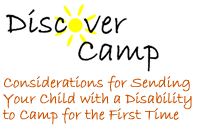Accessibility Statement
This is the official accessibility statement for the Discover Camp web site. If you have any questions or comments, feel free to email the webmaster at “discover” followed by “@indiana.edu”.
Access keys
Most browsers support jumping to specific links by typing keys defined on the web site. On Windows, you can press ALT + an access key; on Macintosh, you can press Control + an access key.
All pages on this site define the following access keys:
- Access key 1 - Home page
- Access key 2 - Skip to content
- Access key 4 - Search
- Access key 0 - Accessibility statement
Standards compliance
- All pages on this site comply with the vast majority of priority 1, 2, and 3 guidelines of the W3C Web Content Accessibility Guidelines. This is a judgement call; many guidelines are intentionally vague and can not be tested automatically. The guidelines have been reviewed and we believe that all these pages are in compliance.
- All pages on this site should validate as HTML 4.01 Strict.
- All pages on this site use structured markup. H1 tags are used for main titles, H2 tags for subtitles. For example, on this page, JAWS users can skip to the next section within the accessibility statement by pressing ALT+INSERT+2.
Links
- Many links have title attributes which describe the link in greater detail, unless the text of the link already fully describes the target.
- Links are written to make sense out of context.
Images
- All content images used in this site include descriptive
ALTattributes. Purely decorative graphics include nullALTattributes.
Visual design
- This site uses cascading style sheets for visual layout.
- This site uses only relative font sizes, compatible with the user-specified “text size” option in visual browsers. You can also use the “Text size” buttons featured on every page of this site to make the text bigger or smaller.
- If your browser or browsing device does not support stylesheets at all, the content of each page should still be readable.
Accessibility references
- W3 accessibility guidelines, which explains the reasons behind each guideline.
- W3 accessibility techniques, which explains how to implement each guideline.
- W3 accessibility checklist, a busy developer’s guide to accessibility.
- U.S. Federal Government Section 508 accessibility guidelines.
Accessibility software
- JAWS, a screen reader for Windows. A time-limited, downloadable demo is available.
- Home Page Reader, a screen reader for Windows. A downloadable demo is available.
- Lynx, a free text-only web browser for blind users with refreshable Braille displays.
- Links, a free text-only web browser for visual users with low bandwidth.
- Opera, a visual browser with many accessibility-related features, including text zooming, user stylesheets, image toggle. A free downloadable version is available. Compatible with Windows, Macintosh, Linux, and several other operating systems.
Accessibility services
- Cynthia Says, a free service to analyze web pages for compliance to accessibility guidelines. A full-featured commercial version is also available.
- HTML Validator, a free service for checking that web pages conform to published HTML standards.
- Web Page Backward Compatibility Viewer, a tool for viewing your web pages without a variety of modern browser features.
- Lynx Viewer, a free service for viewing what your web pages would look like in Lynx.
Related resources
- WebAIM, a non-profit organization dedicated to improving accessibility to online learning materials.
- Designing More Usable Web Sites, a large list of additional resources.
Accessibility books
- Joe Clark: Building Accessible Websites.
- Jim Thatcher and others: Constructing Accessible Web Sites.
This accessibility statement is based on the one found at Mark Pilgrim’s excellent online book on web site accessibility: www.diveintoaccessibility.org
